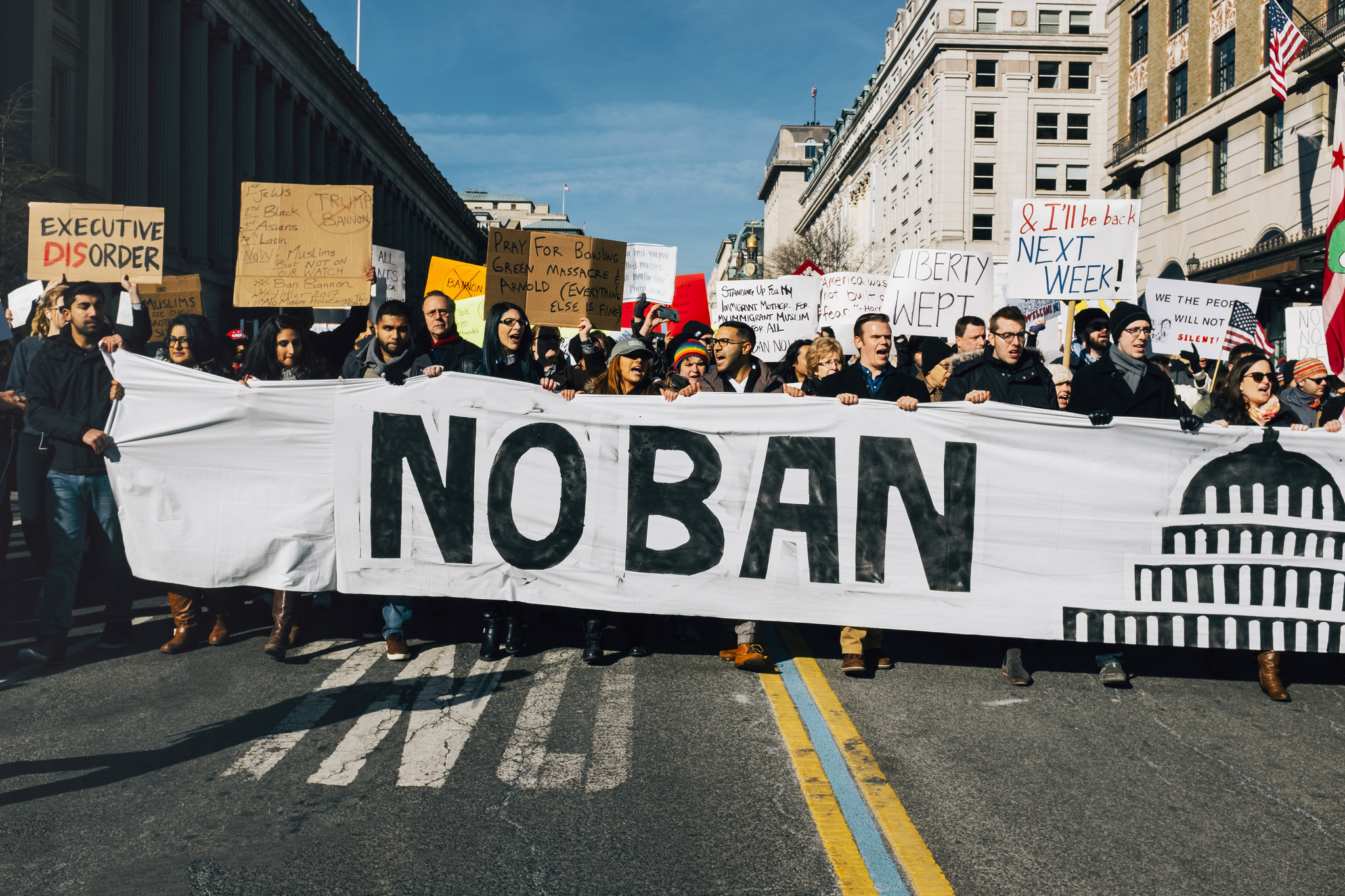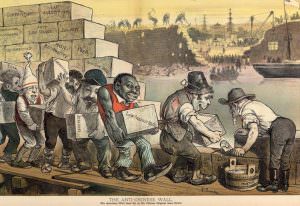7 Racist Exclusions that Reveal America’s Ugly Side
On the occasion of the two-year anniversary of Trump’s Muslim visa ban and Holocaust Remembrance Day, it's worth reviewing some U.S. history. Sasha Patkin / CC BY-NC 2.0
Sasha Patkin / CC BY-NC 2.0
The two-year anniversary of President Donald Trump’s Muslim visa ban and Holocaust Remembrance Day have arrived more or less together, and it is worthwhile reviewing how they reveal an ugly side to America. US history is replete with racism as public policy. It has been more often our history than not, and the era since 1965 has been unusual inasmuch as there has been widespread public pushback against the use of race for policy purposes. Trump’s movement is an attempt to see whether that widespread US consensus of the past few decades can be reversed. Just as the Ku Klux Klan took over the Democratic Party in the 1920s, including the whole state of Indiana, so white nationalism has taken over the Republican Party today, including the GOP majority on SCOTUS.
There have been at least 7 major times in American history when people were excluded from the United States on the basis of race or religion (religion is tied up with race in the racialist imaginary).
1. Chinese Buddhists. Both racism and religious bigotry built up toward Chinese-Americans brought in from 1849 to build the trans-American railroad. In 1882, Congress passed the Chinese Exclusion Act, the first time a whole people were excluded from the United States. In the prejudiced language of the day, that Chinese were Buddhists, Confucianists or Taoists, i.e. “pagans” or “heathens” from an Evangelical point of view, was one of the reasons they should be kept out of the country. The total exclusion lasted until 1943, when 100 Chinese a year began being admitted, which was not much different from total exclusion. In 1965 the Immigration Act ended racial and religious exclusions based on racism and religious fanaticism, including of Chinese. Chinese-Americans have made enormous contributions to the United States, despite the long decades during which they were excluded or disrespected.
2. Japanese Buddhists. In 1907-08, the US and Japan concluded a “gentlemen’s agreement” whereby Japan would limit the number of passports it issued to Japanese wanting to come to the United States. In turn, the city of San Francisco agreed to end the legal segregation of Japanese-Americans in that city (yes, they had their very own Jim Crow). Not satisfied with the agreement, in 1924 racist Congressmen ended Japanese immigration completely. This action angered Japan and set the two countries on a path of enmity.
3. Indian Hindus & Sikhs and other Asians. Not satisfied with measures against Buddhists, white Christians next went after Hindus and Sikhs. The 1917 Asiatic Barred Zone Act excluded from immigration everyone from the continent of Asia– it was aimed at Indians, including especially Sikhs, but also Koreans, Vietnamese, Thai, Indonesians, etc. The provision in the act barring “polygamists” was aimed at Muslims. Would-be Muslim immigrants were asked at their port of entry if they believed a man could have more than one wife, and if they said yes, were turned away. Japanese were not part of the act only because the Gentlemen’s Agreement already mostly excluded them. Filipinos were not excluded because the Philippines was then an American territory (i.e. colony).
4. Syrians-Lebanese. In the early 1920s, the Ku Klux Klan reappeared on the national stage and agitated against immigrants, Catholics, and Jews. The Klan infiltrated the Democratic Party and took it over, and won the whole state of Indiana. The racist 1924 Immigration Act set country quotas based on the percentage of Americans from that country already present in 1890 . . . One consequence of basing the quotas on 1890 rather than, as was originally proposed, 1910, was that populations that came in big numbers during the Great Migration of 1880-1924 were often given low quotas. Populations that came in the eighteenth century or the mid-19th (e.g. in the latter case, Germans) had relatively large quotas. Syria-Lebanon (which were not separated until the French conquest of 1920) were given a quota of 100, even though tens of thousands of Lebanese came to the United States, 10% of them Muslim during the Great Migration. That community produced the great Lebanese-American writer and artist, Kahlil Gibran.
5. Other Middle Easterners, including Armenians. The 1924 Nazi-style quotas based on “race,” which mostly lasted until 1965, excluded most of the Middle East. The quota for Egypt? 100. Palestine? 100. Turkey? 100. Even the persecuted Armenians were given only 100 spaces annually. The racial hierarchies visible in the 1924 act fed into an increasing concern with eugenics, with fears of decadent races and a determination to strengthen the master race by forbidding intermarriage and even by experimenting on live human beings.
6. Jews. In the 1930s when it would have mattered, the US government excluded Jewish refugees from Nazi Germany from coming to America.
It turns out that President Franklin Delano Roosevelt was not responsible for America’s refusal to take more than a few thousand Jewish refugees during the 1930s. He wanted to spend $150 million to distribute millions of Jewish refugees among 10 democratic countries. His failures were imposed on him by a Congress that wouldn’t act and a foot-dragging State Department. By 1940 it was too late, as Europe became a fortress.
But the US in the 1930s did betray its ideals as a refuge for people yearning to be free. The episode of the SS St. Louis, a ship full of 900 Jewish refugees that got close enough to Miami to see its lights before being turned back to Europe, epitomized this failure. A third of the passengers were later murdered by the Nazis.
One Jewish refugee the US did take in was Albert Einstein. How would we not have been better off if we’d had more like him?
The bad economy of the Great Depression was one reason for fear of immigrants. Politicians and labor leaders worried that they would take jobs from workers already in the US. Racism was rampant. In 1924 Congress passed a basically Nazi immigration law that limited immigration on the basis of country — i.e. racial — quotas. The Semitic countries like Syria should, according to this law, keep their people (I recollect that the annual quota for Syrian immigrants was 100– even though tens of thousands of Syro-Lebanese had come from about 1880, including famed writer Kahlil Gibran. All the Norwegians could come who wanted to.)
So simple Aryan racism was partially responsible for the exclusion of the Jews. If the US had thrown open its doors, the 200,000 Jews who went to Palestine in the 30s would have come here and there never would have been Arab-Israeli wars or 7 million Palestinian refugees.
Jews were also seen by some US Neanderthals as having socialist tendencies and so were kept out as radicals. There was talk of the Jewish-Bolshevik conspiracy. (Hatred of Jews was irrational, so that they were blamed for being bankers [they were less than 1 percent of bankers] at the same time they were excoriated for being Marxists). There was also the Society for the Defense of Christianity, so fundamentalists did their part.
All the same arguments against letting in the Jews are now being deployed to keep out the Syrians. Not Christian. Alien ideology. Would take jobs. Nobody is openly saying they aren’t Aryan but the Trumpists might as well be.
7. This past summer, the Roberts court added another star to America’s wall of shame, upholding Trump’s visa ban. The travel ban upheld by a narrow majority on the Supreme Court causes untold heartache to Iranian-Americans, Yemeni-Americans, Syrian-Americans and other groups designated for exclusion. It also injures the First Amendment of the US constitution, which forbids the state to take a position on good and bad religion. It is a sad day that the full court did not agree with the Federal court in Hawaii, which made cogent arguments for the policy having originated in an intention to discriminate on the basis of religion, which is unconstitutional.
I wrote about the ruling of Judge Derek Watson in Hawaii:
-
- “Judge Watson notes, “The clearest command of the Establishment Clause is that one religious denomination cannot be officially preferred over another.” Larson v. Valente, 456 U.S. 228, 244 (1982). To determine whether the Executive Order runs afoul of that command, the Court is guided by the three-part test for Establishment Clause claims set forth in Lemon v. Kurtzman, 403 U.S. 602, 612-13 (1971). According to Lemon, government action (1) must have a primary secular purpose, (2) may not have the principal effect of advancing or inhibiting religion, and (3) may not foster excessive entanglement with religion. Id. “Failure to satisfy any one of the three prongs of the Lemon test is sufficient to invalidate the challenged law or practice.” Newdow v. Rio Linda Union Sch. Dist., 597 F.3d 1007, 1076–77 (9th Cir. 2010).
The Lemon test was used to strike down blue laws that forbade businesses to operate on Sunday. The Supreme Court found that there was no secular purpose to a law that stopped everyone from working on a day of religious observance.
The Establishment Clause says that Congress shall make no law affecting the establishment of religion, which is 18th century English for “Congress shall make no law designating a particular religion as the state religion of the Federal Government.” The Clause mandates that the Government be neutral as between religions. Obviously, a Muslim ban is not religiously neutral.
Watson finds that the EO targets six countries with a Muslim population of between 90% and 97% and so obviously primarily targets Muslims. “
The ban has nothing to do with security–the nationalities banned haven’t engaged in terrorism on US soil in this century. Most terrorism in the US is committed by white nationalists (many of whom support Trump).
The only way to undo Trump’s Muslim ban, and to begin to undo the untold damage he’s done to the country, is to organize and canvass and publish and elect the opposition in 2020. The courts are not going to save us from Trumpism. The GOP Senate is not going to save us from Trumpism. Civility is not going to save us from Trumpism. We’re on our own, friends. The Blue Wave last November has shown the way.
—–
Bonus video:
Here are the Americans who are affected by the Travel Ban
Your support matters…
Independent journalism is under threat and overshadowed by heavily funded mainstream media.
You can help level the playing field. Become a member.
Your tax-deductible contribution keeps us digging beneath the headlines to give you thought-provoking, investigative reporting and analysis that unearths what's really happening- without compromise.
Give today to support our courageous, independent journalists.




You need to be a supporter to comment.
There are currently no responses to this article.
Be the first to respond.